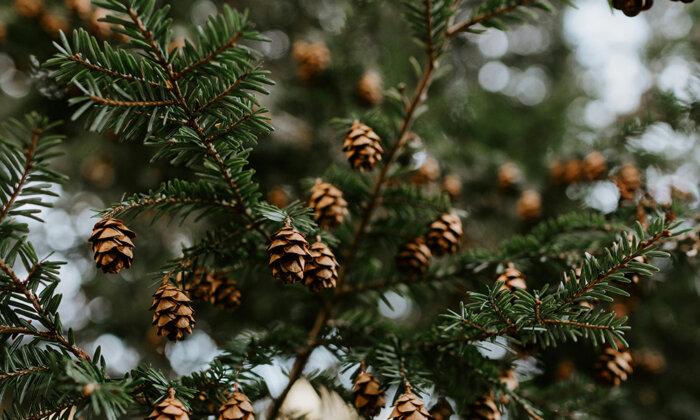Bare Seeds: How Conifers Took Root in the Age of Giants

The Carboniferous period (359 to 299 million years ago) was the age of ferns. For 65 million years, ferns the size of trees reigned as monarchs of the plant world. With powerful trunks several meters in height, they towered over the landscape. Their spores, borne far and wide by the winds, ensured their dominion over a planet made for giants. They grew and multiplied in cycles of generation and decay, enriching the subsoil with rich hydrocarbons for the future by fertilizing the Earth itself.

It was thanks to ferns that conifers developed at the end of the Paleozoic era, in the Permian period (251 to 299 million years ago), which began 48 million years after the Carboniferous. They achieved diversification especially during the Mesozoic era, when mammals and dinosaurs appeared. Jostling with ferns, conifers spread everywhere on the Earth’s surface. Their biological evolution brought forth so much variation that during these ancient geological times, tens of thousands of species of conifers coexisted; today there are fewer than a thousand. The venerable Araucariaceae family (monkey puzzle trees), which is well established in the Southern Hemisphere, is a vestige of the era; it thrived in the Jurassic period, 201 to 145 million years ago.
These plants introduced the world of spermaphytes. Sexual reproduction now took place through seeds, not spores. (Spores do not contain an embryo, whereas seeds do.) All conifers are gymnosperms, a name that comes from the Greek words gymnos, which means “naked,” and sperma, or “seed.” In other words, the new arrivals presented bare seeds: The ovule was not enclosed by the protective shield of the ovary, as would be the case for flowering plants (angiosperms) later on. This is why firs, spruces, pines, cypresses, larches, cedars, redwoods, junipers, and yews all have no ovaries. Most of these trees are monoecious; that is, male and female appear on the same stem. But exceptions do exist. Dioecy is the rule in the genera Araucaria, Taxus (yew), and Cedrus (cedar), on which male and female cones appear separately, on different stems of the tree.
Conifers compensate for contingency by producing millions of pollen grains.
The reproduction of all conifers is anemophilous. This odd-sounding word means that the wind carries their pollen — a poetic evocation of the puffs of Aeolus, the god of wind, making airy particles fly. The pollen of male cones (which often has “balloons” to facilitate travel) is borne aloft and deposited on female cones. At any rate, that’s the idea. In actual fact, results are largely a matter of chance; between changing environmental conditions, misadventure, and the fact that fewer female cones adorn the branches, a substantial amount of pollen does not reach its target. Conifers compensate for contingency by producing millions of pollen grains. Nor is that all. Female cones are designed to cause a vortex as air rushes between the scales housing the ovules, which facilitates the entry of pollen. Most conifers in our climate pollinate in spring; the exception is cedars, which release pollen in the fall. Because they do not flower every year, conifers are less efficient than flowering plants (angiosperms). They are more sensitive to environmental factors and need a large quantity of nutrients to ripen seeds, which risks impairing growth.
Pollination That Depends on Climate
Pollen is contained in sacs (microsporangia); when they dry out and their walls break, the tiny grains come out. In turn, ovuliferous scales open up to allow the pollen in. Hairs or sticky secretions (pollination droplets) often promote better capture. More still, the scales close again when the ovule’s receptive period is over.
For fertilization to occur, the pollen grain must penetrate the ovule and germinate. Some pollens germinate quickly, like spruce. Others are much slower; pine pollen spends almost a year inside the nucellus (the central part of the ovule). The time it takes for the female reproductive system to reach maturity explains these varying intervals.
No matter the species, fertilization takes place in the same way. Once the pollen tube is mature, the cells of the pollen grain divide and produce two male gametes. The pollen tube releases its contents where the ovule is housed. The male gametes separate. One migrates to the nucleus of the ovule, and from their fusion the future embryo is born; the other gamete withers away. Among angiosperms, the second male gamete is used to fertilize the nuclei of the central cell of the ovule; gymnosperms, on the other hand, do not practice double fertilization.
Depending on species and climate, the embryo will reach maturity one to three months after fertilization. Either the cone dries out and turns brown, opening the scales to release the seeds, or it falls apart. A period of cooling is necessary before seeds can germinate.
Having appeared 100 million years before angiosperms, and in spite of robust competition from flowering plants, gymnosperms have endured. Today, this group represents less than 10 percent of the world’s flora and lives mainly in temperate regions. It’s impossible to imagine life on our planet without these majestic trees. Their archaic nature only makes them more imposing. Is there anyone who hasn’t, at one point or another, picked up a pine cone and kept it as a treasure?
Joanne Anton is a Belgian writer and artist. She attended botany courses at the Jardin des Plantes in Paris, where the National Museum of Natural History is located, and botanical illustration lessons with Elisabeth Vitou at the Société National d’Horticulture de France. This article is excerpted from her book “Sexus Botanicus: The Love Life of Plants.”

